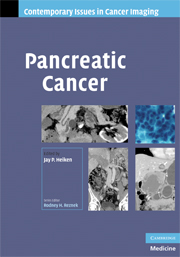Book contents
- Frontmatter
- Contents
- Series Foreword
- Preface to Pancreatic Cancer
- Contributors
- 1 Epidemiology and genetics of pancreatic cancer
- 2 Pathology of pancreatic neoplasms
- 3 Multi-detector row computed tomography (MDCT) techniques for imaging pancreatic neoplasms
- 4 Magnetic resonance imaging (MRI) techniques for evaluating pancreatic neoplasms
- 5 Imaging evaluation of pancreatic ductal adenocarcinoma
- 6 Imaging evaluation of cystic pancreatic neoplasms
- 7 Imaging evaluation of pancreatic neuroendocrine neoplasms
- 8 Role of endoscopic ultrasound in diagnosis and staging of pancreatic neoplasms
- 9 Surgical staging and management of pancreatic adenocarcinoma
- 10 Treatment of locally advanced and metastatic pancreatic cancer
- 11 Rare pancreatic neoplasms and mimics of pancreatic cancer
- Index
- Plate section
- References
4 - Magnetic resonance imaging (MRI) techniques for evaluating pancreatic neoplasms
Published online by Cambridge University Press: 23 December 2009
- Frontmatter
- Contents
- Series Foreword
- Preface to Pancreatic Cancer
- Contributors
- 1 Epidemiology and genetics of pancreatic cancer
- 2 Pathology of pancreatic neoplasms
- 3 Multi-detector row computed tomography (MDCT) techniques for imaging pancreatic neoplasms
- 4 Magnetic resonance imaging (MRI) techniques for evaluating pancreatic neoplasms
- 5 Imaging evaluation of pancreatic ductal adenocarcinoma
- 6 Imaging evaluation of cystic pancreatic neoplasms
- 7 Imaging evaluation of pancreatic neuroendocrine neoplasms
- 8 Role of endoscopic ultrasound in diagnosis and staging of pancreatic neoplasms
- 9 Surgical staging and management of pancreatic adenocarcinoma
- 10 Treatment of locally advanced and metastatic pancreatic cancer
- 11 Rare pancreatic neoplasms and mimics of pancreatic cancer
- Index
- Plate section
- References
Summary
Introduction
The imaging of pancreatic neoplasms often presents a diagnostic challenge to the interpreting radiologist. The radiological questions that need to be answered include the differentiation between benign and malignant entities and the determination of extent of disease and resectability. The latter includes evaluation of the lesion's relationship to the surrounding vasculature and assessment of the presence of local lymphadenopathy and metastatic disease to the liver and peritoneum. This thorough evaluation allows the referring clinician to determine the appropriateness of surgical resection of the lesion in question.
The superior soft tissue contrast provided by magnetic resonance imaging (MRI) compared with other imaging tests has proven highly effective for imaging of the abdomen. Over the past decade, advancements in MRI techniques have resulted in a dramatic improvement in the ability of the radiologist to analyze pancreatic neoplasms. These advancements include the introduction of faster breath-hold sequences to limit motion artifact, the development of improved protocols for optimization of pancreatic contrast enhancement, the use of magnetic resonance cholangiopancreatography (MRCP) to evaluate the relationship of pancreatic lesions to the pancreaticobiliary system, and the use of magnetic resonance angiography (MRA) to evaluate the relationship of pancreatic masses to the adjacent vasculature. Use of these techniques results in accurate diagnosis of malignant pancreatic lesions with 95% sensitivity and specificity. Of similar importance, positive and negative predictive values of cancer non-resectability as high as 90% and 83%, respectively, can be achieved [1].
- Type
- Chapter
- Information
- Pancreatic Cancer , pp. 46 - 57Publisher: Cambridge University PressPrint publication year: 2008



